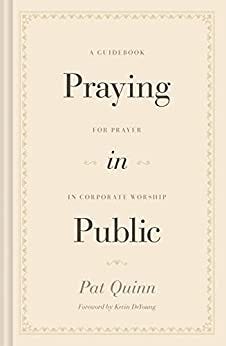Praying in Public: A Guidebook for Prayer in Corporate Worship, Pat Quinn, Crossway 2021.
I had been searching for a book like this for a while, and in the end I only stumbled upon this one by chance. My quest was occasioned by the question that I posed myself - how to lead better congregational prayers. This was partly an outgrowth of my renewed interest and practice of personal prayer this year. The reawakening of a great desire and concomitant need to pray, led me in turn to think as well about how do we pray better together.
This book has a simple and useful format, falling into two halves. The first half consists of seven chapters, each relatively short, in which we examine seven principles that should inform public prayers. The second half, which is relatively long, is a collection of sample prayers. It falls into chapters based on the dominant theme of those prayers.
Chapter 1 surveys "Adoration, Confession, Supplication", which the author notes is a slight compaction of ACTS (Adoration, Confession, Thanksgiving, Supplication), partly because of the way adoration and thanksgiving often interweave. Quinn makes the case that generally our prayers should cover all three of these categories, though not necessarily all at once nor every time weighted equally.
Chapter 2 is about "Bible-Saturated prayer" - how to we utilise Scripture so shape congregational prayer. Quinn gives examples of two modes - quoting more directly, by taking Scripture passages and using them as prayer, as well as 'developed' prayers, where Scripture forms more of the foundational material and motifs for writing new prayers that interweave biblical language and themes.
Chapter 4 treats the Trinitarian grammar of prayer, chapter 5 discusses "thoughtful and reverent prayer", and the challenge of avoiding irreverent, trite, repetitious, and shallow prayers.
Chapter 5 focuses on Gospel-centred prayer: how do we keep the gospel at the centre of our prayers and shaping our concerns. Chapter 6 then focuses on the 'theological' - how do we inform our prayers with depth and gravitas of content, in conversation with tradition.
Last in this section, chapter 7 talks more practically about specifically preparing prayer - writing them, due attention to cadence, eloquence, timing, context, mood.
All of these are very short chapters, with some exercises, scriptural passages to attend to, and a minimum of excess.
The second half of the book is given over to much longer chapters, divided by Adoration, Confession, Supplication, and Composite prayers. These are collections of prayers that Quinn has used in congregational settings, and are presented as a storehouse, to be used as is, if suitable, or to be taken as models, or to be utilised as inspiration. There's a lot of good prayers in here!
I think the first half of this book could honestly have been longer. I wish the author had taken more time and space to work through those points in depth, and then work through more examples of how those principles can be applied in practice.
That said, I did find this a helpful book. Not least, because I don't think I've ever read a book on this topic, and most of my own formation in terms of congregational prayer is (a) listening to others, (b) the Book of Common Prayer and its descendants.
A few things I personally took from this book:
It's good for the words of prayer to sing, i.e. to have an eloquence and richness that, not over the top or showing off, is somewhat elevated, rich in cadence and language and imagery. Prayers ought to move us. And though their role isn't to preach, they should move with the warp and woof of Scripture too.
Secondly, that the structure of supplication doesn't need to be a laundry list. Especially, by some thematic or other structuring devices, I can craft prayers that are not ticking a bunch of boxes, but covering breadth with depth.
Thirdly, to prepare further in advance!
Fourthly, to not be afraid to remix. Another book I've been reading and using in my prayers is Fount of Heaven, which is an anthology of prayers from the early church. It's part of a series. Anyway, I think taking from prayers ancient and modern, and then employing some remixing, to fit context and culture, is a way to appropriately fit together the heritage of the church, and the contemporary moment
Fifthly, to pray earnestly in public, engaging the whole of my being in leading others in prayer too.
So, in sum: a relatively short book, practical and on-target, without an undue amount of scaffolding, that is useful for exactly what it says - doing public prayer better.


